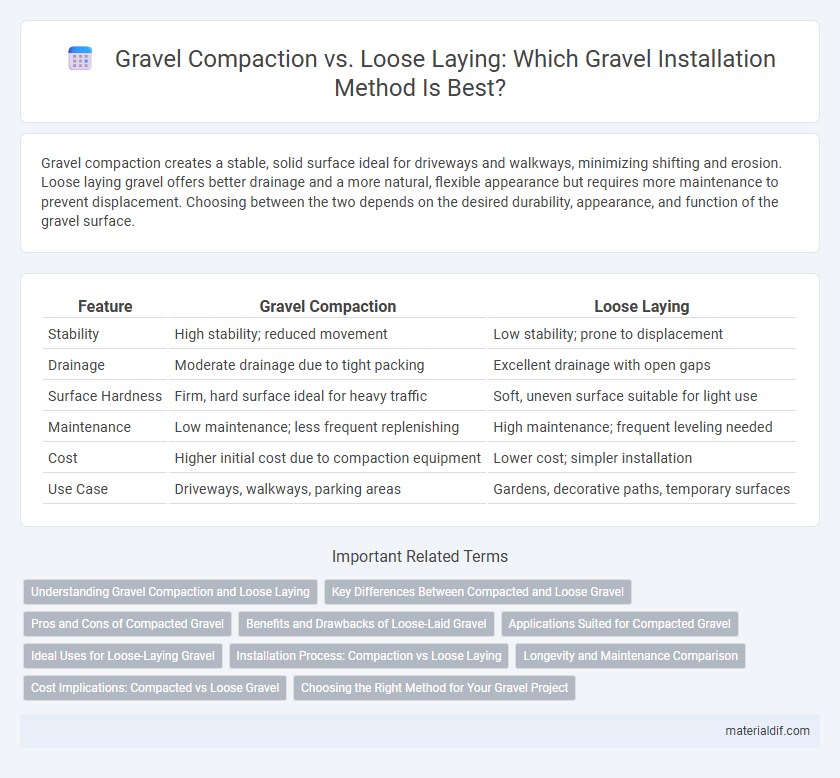Gravel compaction creates a stable, solid surface ideal for driveways and walkways, minimizing shifting and erosion. Loose laying gravel offers better drainage and a more natural, flexible appearance but requires more maintenance to prevent displacement. Choosing between the two depends on the desired durability, appearance, and function of the gravel surface.
Table of Comparison
| Feature | Gravel Compaction | Loose Laying |
|---|---|---|
| Stability | High stability; reduced movement | Low stability; prone to displacement |
| Drainage | Moderate drainage due to tight packing | Excellent drainage with open gaps |
| Surface Hardness | Firm, hard surface ideal for heavy traffic | Soft, uneven surface suitable for light use |
| Maintenance | Low maintenance; less frequent replenishing | High maintenance; frequent leveling needed |
| Cost | Higher initial cost due to compaction equipment | Lower cost; simpler installation |
| Use Case | Driveways, walkways, parking areas | Gardens, decorative paths, temporary surfaces |
Understanding Gravel Compaction and Loose Laying
Gravel compaction increases density by reducing air gaps, creating a stable and durable surface ideal for driveways and pathways. Loose laying involves spreading gravel without pressing it down, offering better drainage but less stability and potential for shifting under weight. Choosing between gravel compaction and loose laying depends on desired surface firmness, drainage needs, and longevity of the installation.
Key Differences Between Compacted and Loose Gravel
Compacted gravel offers enhanced stability and load-bearing capacity, making it ideal for driveways and pathways requiring firm surfaces. Loose gravel provides superior drainage and easier installation but can shift under heavy traffic or adverse weather conditions. The key difference lies in the degree of particle interlock, where compacted gravel particles are tightly bound, reducing movement and erosion compared to loose gravel's more flexible, unstable composition.
Pros and Cons of Compacted Gravel
Compacted gravel offers enhanced stability and durability, reducing surface movement and minimizing erosion, making it ideal for driveways and pathways with heavy traffic. However, it can limit drainage efficiency compared to loose laying, potentially causing water pooling and increasing maintenance needs in wet conditions. The dense surface also makes future modifications or repairs more labor-intensive due to the harder material structure.
Benefits and Drawbacks of Loose-Laid Gravel
Loose-laid gravel offers excellent drainage and ease of installation, making it ideal for temporary paths and garden areas where flexibility is needed. However, it can shift under heavy traffic, causing uneven surfaces and requiring frequent maintenance to prevent displacement. While loose gravel reduces compaction-related soil stress, it lacks stability compared to compacted gravel, which may limit its use in high-load applications like driveways.
Applications Suited for Compacted Gravel
Compacted gravel provides a stable, durable surface ideal for high-traffic areas such as driveways, walkways, and parking lots, where load-bearing capacity and erosion resistance are crucial. Its dense structure minimizes shifting and settling, making it suitable for base layers in construction projects and roadbeds. In contrast to loose laying, compacted gravel enhances drainage control and reduces maintenance requirements in outdoor applications.
Ideal Uses for Loose-Laying Gravel
Loose-laying gravel is ideal for applications requiring excellent drainage and easy access, such as garden pathways, driveways, and base layers for patios. Its permeability helps prevent water pooling and soil erosion, making it suitable for areas prone to heavy rainfall. This method also allows for simple maintenance and quick adjustments without heavy machinery.
Installation Process: Compaction vs Loose Laying
Compacted gravel installation requires the use of mechanical plate compactors or roller compactors to firmly press and bind the aggregate particles, creating a stable and durable surface ideal for driveways and walkways. In contrast, loose laying gravel involves spreading the aggregate without compaction, resulting in a more flexible and permeable surface suited for garden paths or decorative areas. Proper compaction enhances load-bearing capacity and reduces gravel displacement, while loose laying facilitates drainage but may require periodic replenishment and maintenance.
Longevity and Maintenance Comparison
Gravel compaction significantly enhances longevity by creating a stable, firm surface that resists erosion and minimizes displacement, reducing the need for frequent replenishment. Loose laying gravel, while easier to install, tends to shift under traffic and weather conditions, leading to increased maintenance efforts such as regular raking and topping up. Compacted gravel also improves drainage and load distribution, extending the lifespan of driveways and paths compared to loose gravel layers.
Cost Implications: Compacted vs Loose Gravel
Compacted gravel requires additional equipment and labor, increasing upfront installation costs compared to loose gravel, which is quicker and cheaper to lay. While loose gravel may reduce initial expenses, it often demands more frequent maintenance and replenishment, raising long-term costs. Considering project budgets, choosing compacted gravel can lead to cost savings by minimizing future upkeep and improving surface stability.
Choosing the Right Method for Your Gravel Project
Gravel compaction enhances stability and load-bearing capacity, making it ideal for driveways, pathways, and foundations where durability is crucial. Loose laying offers better drainage and a natural appearance, suitable for decorative landscaping or temporary installations. Selecting the right method depends on the project's purpose, expected traffic, and environmental conditions to balance functionality and aesthetics.
Gravel Compaction vs Loose Laying Infographic

 materialdif.com
materialdif.com